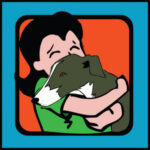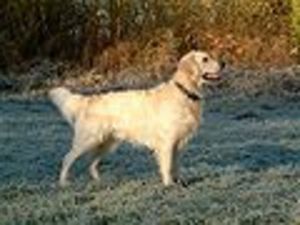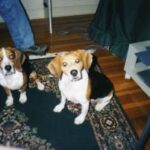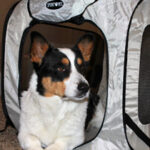A typical day for a greyhound starts off around six in the morning when the kennel personnel arrive to do what is known as a turnout. This phrase simply describes all of the dogs being let out of their crates so that they can go to the bathroom out in an enclosed “turnout pen”. Most greyhound racing kennels will do four turnouts in a day; one early in the morning, another after the dogs eat around 10am, a third in the mid-afternoon, and one final one at some point in the early evening hours.
Virtually every greyhound racing kennel has a similar set up where there are rows of double-decker crates on each side of the building, with the lighter females occupying the “top bunks”. These crates are made of either metal or wood, with wire mesh doors that the greyhounds can peer out of. As turnout begins, great care needs to be taken when lowering the greyhounds from the top crates, as they are happy to be going out and very fidgety. These top crates are a little bit over three feet off of the ground, and the dogs should have a hand placed under their chest and one on their collar before being guided safely to the floor.
Before any greyhound can be turned out, they need to have their kennel muzzles placed on their heads. The kennel muzzle is sturdier than the racing muzzles that greyhounds wear on the track and is made up nowadays of plastic. They hang on a peg on the greyhound’s crate door, within easy access of the kennel staff as they turn out each dog. The cage part of the muzzle covers the mouth area of the greyhound, allowing it to drink water but at the same time making it hard for them to bite other greyhounds in the turnout pens. The muzzle goes on around behind the greyhound’s ears very easily before it is allowed to run outside with the other dogs. The kennel muzzle also comes with a nose guard, a piece of plastic designed to keep the muzzle from wearing against the top of the greyhound’s long snout.
Once the muzzle has been placed correctly on the greyhound and she has been lowered to the floor, the fun begins in earnest. Each greyhound has their own peculiar set of habits during turnouts. Some will play around in the kennel a bit before going outside to take care of their business, while others will go right outside, relieve themselves, and then decide to come charging back in to meet their pals that are just coming out. Many will calmly walk out the door, go to the bathroom, and then pick a place to relax and lay down in the turnout pen until it’s time to go in. Still others have to make the rounds and investigate everything they possibly can, barking at and playing with other greyhounds along the way.
During a turnout, once all of the dogs are outside, the kennel staff must watch them closely. They will be out in the turnout pen with the dogs, picking up their stools with a rake and shovel and depositing them into a pail that will later be emptied into a waiting dumpster. The kennel people are also in the turnout pen to make sure that the dogs behave. Greyhounds make the greatest, calmest pets in the world, but when they are out in groups they can fight amongst themselves if not carefully monitored. Even with their kennel muzzles on, these dogs are capable of causing each other serious damage when they go at it. The absolute last thing kennel workers want to have to deal with is a greyhound fight during turnout, and great pains are taken to see that the dogs get along with one another.
The greyhounds have access to buckets of fresh water during their turnouts, water that is constantly changed as the various dogs drinking from the pails can get the water a bit dirty after awhile. In the summer the greyhounds will drink more water than in the colder winter months. The dogs take turns waiting to get a drink, and certain pecking orders are established amongst them. Once a greyhound has gone to the bathroom and had a drink of water, it will either plop itself down somewhere in the turnout pen and take a siesta, especially in the spring and summer, or it will interact and mingle with the other dogs and people in the pen until it is time to go back inside.
If it seemed that all of these greyhounds going out into the turnout pen was chaotic, you should see them all coming back into the kennel building at once. The gate to the turnout pen is opened and the dogs will come flooding back into the kennel, making the entire scene resemble a jailbreak in reverse. Inside the kennel the dogs will go to their crates and wait to be put back inside or they will mill around and play until they have been corralled by the staff and put back into their homes. The females can easily jump into these upper berths, and once inside they snuggle up into the shredded paper that is used for their bedding. To be able to tell up to thirty-five greyhounds apart from one another would seem a very difficult task to the untrained eye, but the kennel staff have long since learned to tell one racer from another by their colors and mannerisms.
When all of the females have gone out, the scenario repeats itself with the males, who live in the lower crates. The males are more apt to start trouble among each other once they get out into the turnout area, so this has to be taken into account. The optimum situation will have one person standing out keeping an eye on things in the pen while other kennel personnel are letting the dogs out of their crates. When the boys are let back in they are put away in their crates. The water that is in the pens will be dumped and fresh water prepared for the next turnout. All waste will have been picked up and when the “honey buckets” are full, they will have to be emptied.. Any holes that have been dug by mischief-making greyhounds will need to be filled in, and in the winter, any slick spots that have developed in the turnout pens will be covered with a bit of sand. from start to finish an average turnout lasts about one hour, with some lasting longer as the kennel people go about the job of changing the bedding and keeping it fresh.




